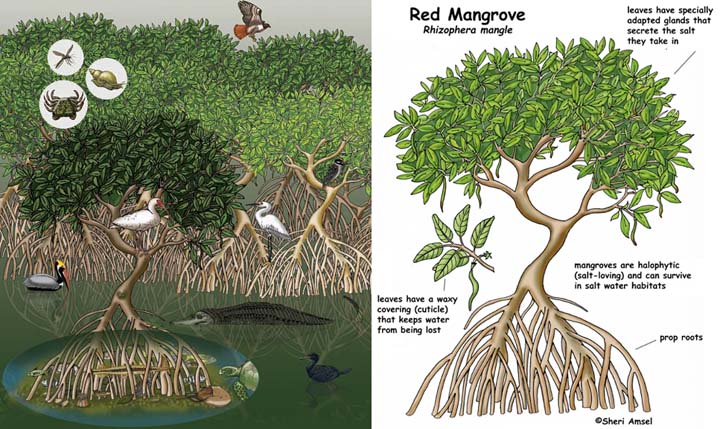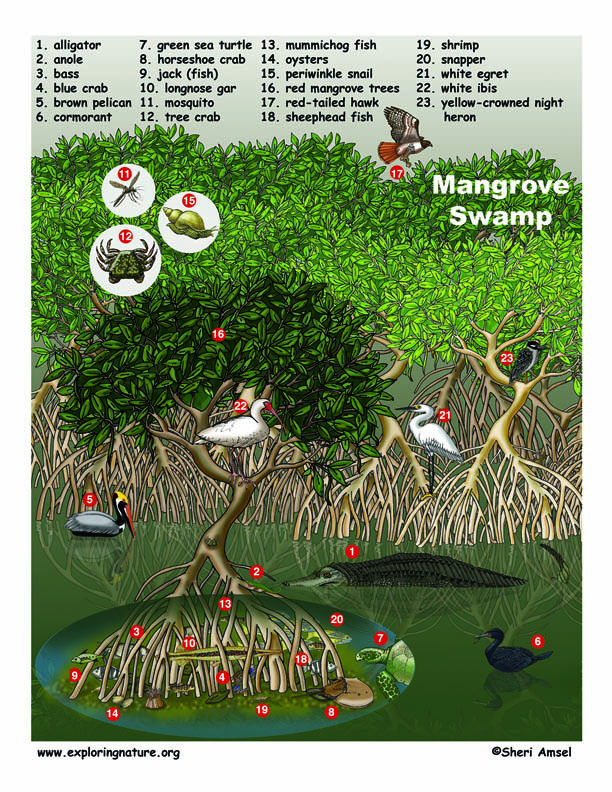

In the U.S. they are found along the coast from southwestern Florida, in the Everglades, up all along the Gulf of Mexico coast around to Texas. Mangroves can live in both fresh and salt water. They are also found in the coastal tropics of Africa, Asia, Australia and South America.
Mangrove swamps are found along the coasts in tropical and subtropical locations. The plants there have to be able to live in salty water. This is called halophytic, which means salt-loving. Because mangroves often line estuaries, where freshwater rivers flow into the ocean, the water is often brackish – a mix of fresh and salt water. As the water rises and falls every day with the changing tides, the saltiness (salinity) also changes. Because of this the mangroves have to be adapted to the changing salinity. Their leaves have specially adapted glands that give off (secrete) the salt they take in plus a waxy covering (cuticle) that keeps their own water from being lost. This allows them to live in a salty environment without drying out.
Mangroves are threatened by habitat destruction as they were once cleared for beach front development. Their loss is marked by increased erosion, animal species loss, and increased storm damage and it is now illegal in Florida to cut down a mangrove tree.
Mangrove swamps are rich habitats full of animals like the snowy egret, white ibis, brown pelican, frigatebirds, cormorants, mangrove cuckoos, herons, manatees, monkeys, turtles, lizards like anoles, red-tailed hawks, eagles, sea turtles, American alligators and crocodiles. The mangrove roots house smaller animals like the mangrove tree crab, spotted mangrove crab, snails, barnacles, oysters, mussels, anemones, and sponges. Because they have thick vegetation for hiding and are rich in organic matter (dropped leaves, buds, seeds, bark, etc.) which provides food, they act as a nursery habitat for many species of larval shrimps and crabs. Many species of fish also feed there including: bonefish, tarpon, sheepshead, jacks, snappers, gar, mullet and moles. Other invertebrates (no backbone) are also found there like worms, protozoa, bacteria. The bacteria in mangroves are very important, acting as decomposers and breaking down organic matter making it is available to the food web.
There is not a lot of plant diversity (number of species) in mangrove swamps. There are three kinds of mangroves: black, red and white.
The most common species of mangrove found in the inland swamps is the black mangrove. Black mangroves have roots that stick straight out of the water to reach the air. This is important for the plant, which is rooted in underwater soil where gas exchange is poor. These roots are called pneumatophores.
Red mangroves are the most common coastal mangroves. They are the mangroves that have the strange, arching roots – called prop roots – that most people think of when they hear of mangroves. Prop roots grow down on the trunk of the mangrove until they reach the surface of the water where they will branch over and over forming a thick web of roots. These roots do the plant's gas exchange when out of the water. They also provide shelter for many animal species. The red mangroves located on the ocean side of their habitat are vitally important because they trap sand. This slows coastal erosion and builds a foundation for other plants to grow like sea grape, buttonwood, pines, ferns, black and white mangroves. Red mangroves also protect the coast from storm damage by slowing storm surges and tidal waves.
White mangroves grow further inland out of the water, so do not need arching roots or special structures for reaching the air.
_____________________________________________________________________________________________________________
Related Activity:
Mangrove Coloring Page
Related Testing and Assessment:
Mangrove - Multiple Choice Quiz
Mangrove Labeling Page
_____________________________________________________________________________________________________________
When you research information you must cite the reference. Citing for websites is different from citing from books, magazines and periodicals. The style of citing shown here is from the MLA Style Citations (Modern Language Association).
When citing a WEBSITE the general format is as follows.
Author Last Name, First Name(s). "Title: Subtitle of Part of Web Page, if appropriate." Title: Subtitle: Section of Page if appropriate. Sponsoring/Publishing Agency, If Given. Additional significant descriptive information. Date of Electronic Publication or other Date, such as Last Updated. Day Month Year of access < URL >.
Amsel, Sheri. "Mangrove Swamp" Exploring Nature Educational Resource ©2005-2024. December 13, 2024
< http://www.exploringnature.org/db/view/Mangrove-Swamp >

